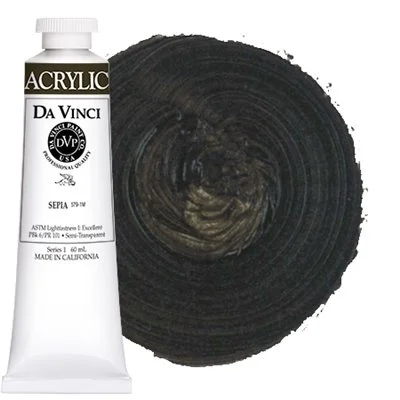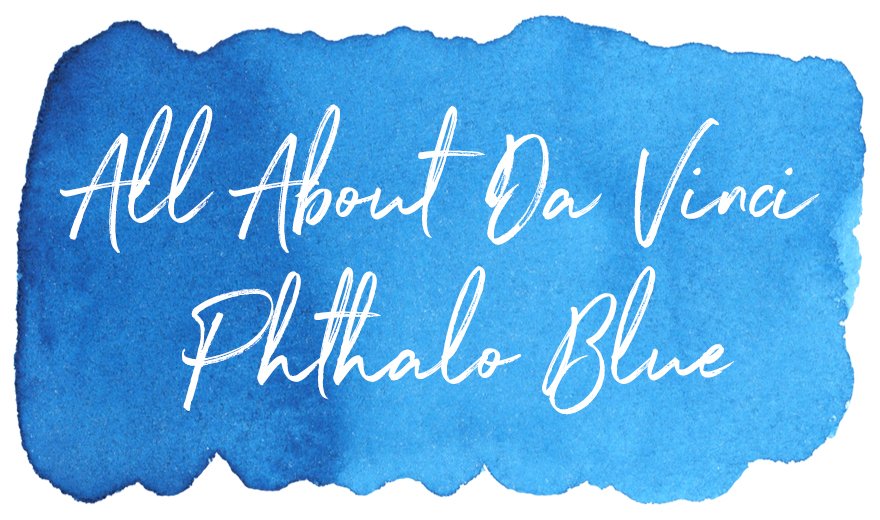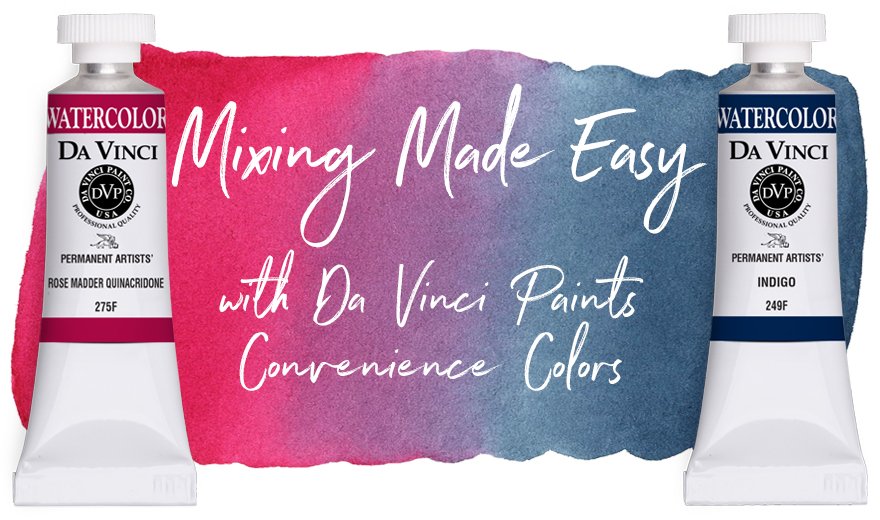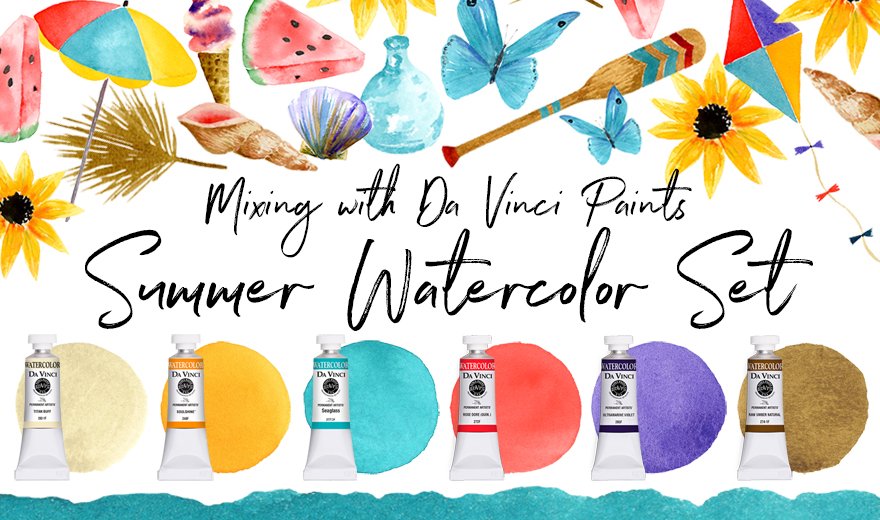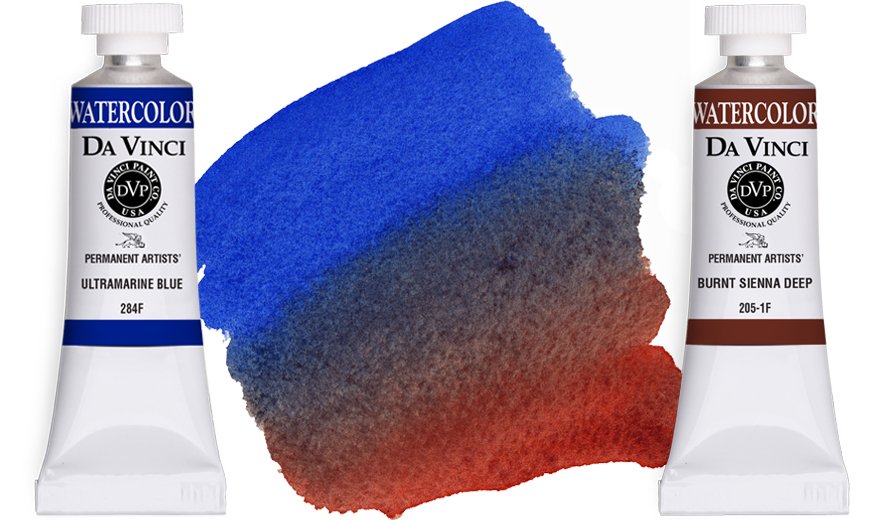Mixing Darks with Da Vinci Ultramarine
When it comes to mixing blacks and grays, colors that are also known as darks or neutrals in a painting, gaining a dark black and a range of grays with a two-color mix is very simple. Da Vinci’s Ultramarine Blue is one of easiest colors to use for these tasks. Let's explore some common ways that gorgeous grays and blacks can be achieved with Da Vinci Paints!
This article is about neutral grays and blacks, but neutrals can encompass a wide range of colors. In a painting, neutral colors tend to recede and shift the focus onto other colors or objects. Neutrals may also be used to depict shadows or soften (aka tone) colors in mixes. Regardless of how you define the word "neutral," these colors are extremely handy!
Mixing Neutrals with Watercolor
One of the easiest ways to create a dark or neutral with Ultramarine Blue watercolor is to mix it with an orange or earth color. Whichever color is dominant in the mix will shift the color temperature of the resulting color. For example, a larger ratio of brown or orange to blue will create a warm black, and the opposite ratio will produce a cooler shade. These darks can easily be diluted into a wide range of neutrals and shadow colors that will read as "gray" in a painting.
A popular black or gray mix is Ultramarine combined with Burnt Sienna or Burnt Sienna Deep (see example mix at our post), but for extra-rich darks, try Ultramarine mixed with Benzimida Orange Deep or Raw Umber.
If you're having a hard time achieving really rich blacks in watercolor mixes, try mixing undiluted colors straight from the tube. That usually solves it!
Da Vinci Black & Gray Watercolors
One of the great things about paint, and art in general, is that you're generally free to set your own rules. Many artists prefer to keep a gray or black (or both!) in a palette to use for value studies, as a foundation mix, or whenever black or gray is needed for a subject. Not only are these neutrals lovely in their own right, but they can also be shortcuts to mixing fantastic darks.
The examples above showcase a few of Da Vinci's popular watercolor neutrals: Neutral Tint, Payne's Gray, and Lamp Black. Unlike some black pigments, all three of these Da Vinci Paint colors are non-toxic and vegan.
Mixing Neutrals with Oil Paint
Just like with watercolor, Da Vinci's Ultramarine Blue oil paint mixes easily with earth colors like Burnt Sienna or Burnt Umber to produce a fantastic range of blacks. To create a gray, simply add white. Da Vinci Ultramarine Blue oil paint also blends beautiful darks when mixed with many earth reds like Venetian Red. For a similar example, see Da Vinci's Warm Up Trio that showcases Venetian Red blended with Prussian Blue.
For a single-color neutral, dark blue, green, or earth colors can work well as neutrals or darks in a painting, especially when used in masstone. However, many oil painters keep a tube of black or gray paint in their palettes to use for mixes, painting, and toning or shading colors.
Da Vinci Lamp Black artist oil paint is a solid choice that’s also vegan and nontoxic. When mixed with white, Lamp Black will produce an almost unlimited value range of grays.
More Options for Black or Gray Artist Oils
Da Vinci Ivory Black Artist Oil
Da Vinci Blue Black Artist Oil
Da Vinci Payne’s Gray Artist Oil
Da Vinci Magnetite Genuine Artist Oil
Dazzling Darks Straight from the Tube
We hope these combos inspire you to try your own DIY darks, but in addition to the excellent options mentioned above, Da Vinci Paints has a fine selection of artist-grade colors that can be used as neutrals. With the exception of Ivory Black, all of the featured colors are vegan, so you can fill your palette to suit your personal style. Click on the images to explore more Da Vinci colors.
SUBSCRIBE TO DA VINCI PAINTS
Receive notifications of new posts & promotional offers.
Da Vinci Paints never shares subscriber information.
We'd love to see what you create with Da Vinci Paints! Be sure to tag us on social media.
@DaVinciPaints #DaVinciMoment







